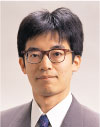 |
 |
 |
Professor |
Assistant Professor |
Research Associate |
|
First and foremost, the Image Processing Laboratory engages in research and development of image-based pattern recognition including some areas of Artificial Intelligence, database organisation, retrieval, and robotics. More specifically, as can be seen from the background information and the recent research publications of the members of the laboratory, object tracking in a time-varying image, image retrieval from video data, character recognition of telop in a video image and extracion of the Internet community are our current focus. Related to the recent progress of the web, a huge amount of multimedia data without index becomes available to store in our PC's. However, no sophistcated methodology to manage such data has been developed so far. So that we are solicited to attach an index to each data. Our research aim is to develop algorithms to realize automatic annotation to real word data for integrated retrieval of multimedia information. The algorithms include self-organisation and transformation among representation of multimedia and feature extraction and recognition of real data. Real world data includes video, still image, speech, music, sound, and text each of which has not been indexed by labels. An example of multimedia integration retrieval called "CrossMediator" developed by ten-year project (1992-2002) RWC of METI (Japan). Some parts of CrossMediator have been in the commercial market by through a private company. Prof. R.Oka was a chief of group which developed "CrossMediator". Our laboratory will pursue to develop more sophisticated functions which might reveal a new generation of the Internet. Speech retreival system used in CrossMediator is used for developing new types of commercial products. One of the recent progress is developing a set of algorithms for spotting recognition and tracking objects in a time-varying image. These algorithms enable to realize automatic anonotation of video image capturing moving objects. Another recent progress is developing a spotting algorithm for song wave retrieval. A large amount of song wave data is available for anyone along with the progress of storage hardware of music data. But the progress of technology for accessing the song wave data seems quite slow so that we must use conventional and not sophistcated tools. Our new software can provide users a convenient way to find and rerieve the song wave data by singing an arbitrary part of it which he/she wants to hear. The Internet is regarded as a network composed of virtual communities. Visualization of the community is becoming an important research target. Our lab is developing a sophistcated algorithm based on so-called Associated hyper-linked word space (A-space). We use the algorithm to detect clusters each of which corresponds a virtual community. Visualization of each virtual community is realized by showing the content extracted from the web pages included the community. |
Refereed Proceeding Papers
| [naruse-01:2006] |
Keitaro Naruse and Masao Kubo. Lognormal Distribution
of BBS Articles and its Social and Generative Mechanism. In
2006 IEEE/WIC/ACM International Conference on Web Intelligence
(WI2006), 2006. |
| The objective of this paper is to understand an aspect of human social interaction
in public bulletin board systems (BBSs). When an individual submits
an article to a BBS, it is potentially influenced by articles from other users. A
submission sometimes starts a long and hot chain of articles, but often does
not. This paper tries to answer the question of why and how such a chain of
articles emerges. In other words, we attempt to reveal a mechanism linking the
individual voluntary activity of article submission and the social phenomenon
of a long article chain. |
|
| [naruse-02:2006] |
Masao Kubo and Keitaro Naruse. How are articles distributed
in BBSs and how is the distribution derived? In 10th Asia-Pacific
Workshop on Intelligent and Evolutionary Systems (IES2006), 2006. |
| In this paper, we investigate characteristics of BBS community, we first collect
a set of logs from an actual BBS and analyze what characteristics are common
inBBSs. Then, we introduce simulation model of BBS community and verify
the model by showing that the simulation results fit well to actual logs, and we
suggest that the interaction in the model can exist between actual people. |
|
| [naruse-03:2006] |
Keitaro Naruse and Makiko Tashima. Statistical Analysis of Facial
Expression Combinations. In First International Conference on Kansei
Engineering and Intelligent Systems (KEIS Åf06), 2006. |
| This research focused on the generation of facial expressions for the provision of
improved user-friendly computer based interaction. Multiple impressions produced
by facial expression are shown as a facial expression combination. The
facial expression is recognized based on Facial Action Coding System (FACS),
and it is generated by combination optional Action Units (AU). The purpose
of this research is to generate facial expression combinations and make clear
the relation between the facial expression combinations and impression having
on human beings. We carried out a questionnaire survey in order to investigate
the relation, and analyzed the data employing a statistical method. |
|
| [oka-01:2006] |
Yuuichi Yaguchi and Ryuichi Oka. Accompaniment included song
waveform retrieval based on frame-wise phoneme recognition. In 152nd Meeting (4th joint meeting of the Acoustical Society of America and
theAcoustical Society of Japan), page 4aMU5. the Acoustical Society
of America, Nov. 2006. |
| We propose a song wave retrieval method. Both song wave data and a querywave
for song data are transformed into phoneme sequences by frame-wise labeling of
each framefeature. By applying a search algorithm, called Continuous Dynamic
Programming (CDP), to thesephoneme sequences, we can detect a set of similar
parts in a song database, each of which issimilar to a query song wave. Song
retrieval rates hit 78 percent in four clauses from wholedatabases. Differencesin
each query from song wave data and speech wave is investigated. |
|
| [oka-02:2006] |
Takashi Kawai and Ryuichi Oka. A Segmentation-free method for
extracting a pair of similar parts between images. In Proceedings of
meeting on Image Recognition and Understanding, pages IS1.53. IEICE,
July. 2006. |
| A segmentation-free algorithm for extracting a pair of similar image partsis a
key technology of image retrieval system. The proposed method allows users
not to segment botha query image and images to e retrieved in database in
advance. We propose a novel method torealize this function by using so-called
line-image Continuous Dynamic Programming. |
|
| [oka-03:2006] |
Naoki Misoo and Ryuichi Oka. A Method of Non-linear Registration
Using Line-image ContinuousDynamic Programming and its Application
to Omitted Object Detection. In Proceedings of meeting on Image Recognition
and Understanding, pages IS2.8. IEICE, July. 2006. |
| A new method using Continuous Dynamic Programming is proposed for automatic
visualinspection of omitted objects. The proposed method is called
Line-image Continuous DynamicProgramming for non-linear matching between
arbitrary parts of two images. The key concept ofLine-image CDP is to use a
line-wise reference part of input image and apply ContinuousDynamic Programming
to a whole image of input image to detect similar line-wise parts ofinput
image. We apply the proposed method to a real image capturing parts of car
which sometimeshappens to omit parts which should be attached. The results
of our experiment gives a set ofpapa meters to use automatic registration to
detect the omitted parts. |
|
| [oka-04:2006] |
Seiichiro Matuya Satoshi Mori and Ryuichi Oka. Range Image Extraction
from Sequence of Image with a Single CameraBased on Spotting Recognition of Image Object. In Proceedings of meeting on Image Recognition
and Understanding, pages IS2-3. IEICE, July. 2006. |
| In this paper, we implement distance estimation between a camera and an
object in animage sequence with a single camera as a application of spotting
recognition of image.We acquire the pixel correspondence between objects in
consecutive two images captured by a singlecamera applying spotting recognition
of image. Consequently, the corresponding problem, which isthe most
difficult problem in stereo matching, is solved. Through the experiments, it
wasconfirmed that the shape of the object is the image sequence was recognized
with a high precision.As a result, object recognition and range image
extraction were implemented simultaneously. |
Unrefereed Papers
| [naruse-04:2006] |
Keitaro Naruse. Representation of Virtual Muscle Oscillation for
Robot Control by Communicating Sequential Processes. In 2007 JSPE
Spring Conference, 2006. |
| [naruse-05:2006] |
Masao Kubo and Keitaro Naruse. Visualization of Online Community.
In SICE System Integration Division Conference 2006, 2006. |
| [naruse-06:2006] |
Keitaro Naruse and Makiko Tashima. Analysis of Impression on
Facial Expression Combinations. In SICE System Integration Division
Conference 2006, 2006. |
| [naruse-07:2006] |
Keitaro Naruse, Eisuke Mayuzumi, Kenta Ide, and Keigo Suenaga.
Small humanoid control by Web-service and virtual muscle oscillation
method. In 2006 JSPE FallConference, 2006. |
| [naruse-08:2006] |
Keitaro Naruse. Linked space search by arranging to Euclid
space. In 22nd Fuzzy System Symposium, 2006. |
Grants
| [naruse-09:2006] |
Keitaro Naruse. Ministry of Education Scientific Research Fund,
2004-2006. |
Academic Activities
| [naruse-10:2006] |
Keitaro Naruse, 2006. First International Conference on Kansei Engineering and Intelligent Systems (KEIS Åf06) |
| [naruse-11:2006] |
Keitaro Naruse, 2006. Paper Reviewer, 2006 IEEE International Conference on Computer and Information Technology, (CIT2006) |
| [naruse-12:2006] |
Keitaro Naruse, 2006. Registration Chair, 2007 IEEE International Conference on Computer and Information Technology, (CIT2007) |
| [naruse-13:2006] |
Keitaro Naruse, 2006. Session Organizer, SICE System Integration Division Conference |
| [naruse-14:2006] |
Keitaro Naruse, 2006. Special Journal Editor, IPSJ |
| [naruse-15:2006] |
Keitaro Naruse, 2007. Technical Program Committee, 2007 IEEE International Conference on Computer and Information Technology, (CIT2007) |
| [naruse-16:2006] |
Keitaro Naruse, 2006. Paper Reviewer, 2006 IEEE/RSJ International Conference on Intelligent Robots and Systems (IROS2006) |
| [naruse-17:2006] |
Keitaro Naruse, 2006. Paper Reviewer, JSAI |
| [naruse-18:2006] |
Keitaro Naruse, 2006. Paper Reviewer, Society of Tourism Infomatics |
| [oka-05:2006] |
Ryuichi Oka, May 2006. Reviewer of submitted papers, The Acoustic Society of Japan |
| [oka-06:2006] |
Ryuichi Oka, May 2006. Reviewer of submitted papers, The Institute of Electronics, Information and CommunicationEngineers |
| [oka-07:2006] |
Ryuichi Oka, April 2006. Member of editorial committee, Japanese Society for Artificial Intelligence |
| [oka-08:2006] |
Ryuichi Oka, April 2006. Reviwer of submitted papers, the Seven Inter. Conf. on Computer and Information Technology |
Patents
| [naruse-19:2006] |
Keitaro Naruse. System, algorithm, method, and program of user
number estimation, 2006. under review |
Ph.D and Other Theses
| [naruse-20:2006] |
Shgohei Sekii. Graduation Thesis: Creating Character Animation
by Automatic Generation of Control Point in Spatial Keyframing,
University of Aizu, 2006. Thesis Advisor: Keitaro Naruse. |
| [naruse-21:2006] |
Daiji Okanoya. Graduation Thesis: Using Genetic Algorithm to
Enable Motion in a Walking Object, University of Aizu, 2006. Thesis Advisor: Keitaro Naruse. |
| [naruse-22:2006] |
Kana Matsushita. Graduation Thesis: Behavior of which the Talk
Spreads, Characterized by Sand-pile Model, University of Aizu, 2006. Thesis Advisor: Keitaro Naruse |
| [naruse-23:2006] |
Akane Kikuchi. Graduation Thesis: Finding Central Figure of
Infomation Transmission in a Social Network Based on Centrality, University
of Aizu, 2006. Thesis Advisor: Keitaro Naruse |
| [naruse-24:2006] |
Masako Okudera. Graduation Thesis: Break Time Picking by
Pattern Recognition, University of Aizu, 2006. Thesis Advisor: Keitaro Naruse |
